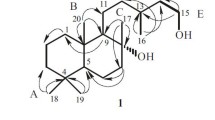Abstract
Cerumen, also known as ear wax, is a yellowish waxy substance secreted from specialized glands in the ear canal of mammals. Human cerumen is rich in protein (mainly keratin), lipids (long-chain fatty acids), alcohols, squalene, and cholesterol. To-date the role of cerumen is not totally clear but it is believed to have antimicrobial properties. Here we describe the isolation of multiple bacterial species from human cerumen (among them many Staphylococcus spp. and, interestingly, multiple Bacillus spp.) showing that many of these bacteria harbor biochemical traits enabling them to utilize different cerumen components for their growth. We also suggest the existence of microbial consortia.

Similar content being viewed by others
References
Alvord LS, Farmer BL (1997) Anatomy and orientation of the human external ear. J Am Acad Audiol 8:383–390
Brook I (1981) Microbiological studies of the bacterial flora of the external auditory canal in children. Acta Otolaryngol 91:285–287
Campos A, Arias A, Betancor L, Rodríguez C, Hernández AM, López Aguado D, Sierra A (1998) Study of common aerobic flora of human cerumen. J Laryngol Otol 112:613–616
Campos A, Betancor L, Arias A, Rodríguez C, Hernández AM, López Aguado D, Sierra A (2000) Influence of human wet cerumen on the growth of common and pathogenic bacteria of the ear. J Laryngol Otol 114:925–929
Chai TJ, Chai TC (1980) Bactericidal activity of cerumen. Antimicrob Agents Chemother 18:638–641
Chiang SP, Lowry OH, Senturia BH (1955) Micro-chemical studies on normal cerumen. I. The lipid and protein content of normal cerumen as affected by age and sex. Laryngoscope 65:927–934
Chiang SP, Lowry OH, Senturia BH (1957) Micro-chemical studies on normal cerumen. II. The percentage of lipid and protein in casual and fresh cerumen. J Invest Dermatol 28:63–68
Chun J, Lee J-H, Jung Y, Kim M, Kim S, Kim BK, Lim YW (2007) EzTaxon: a web-based tool for the identification of prokaryotes based on 16S ribosomal RNA gene sequences. Int J Syst Evol Microbiol 57:2259–2261
Costello EK, Lauber CL, Hamady M, Fierer N, Gordon JI, Knight R (2009) Bacterial community variation in human body habitats across space and time. Science 326:1694–1697
Felske A, Rheims H, Wolterink A, Stackebrandt E, Akkermans AD (1997) Ribosome analysis reveals prominent activity of an uncultured member of the class Actinobacteria in grassland soils. Microbiol 143:2983–2989
Frank DN, Spiegelman GB, Davis W, Wagner E, Lyons E, Pace NR (2003) Culture-independent molecular analysis of microbial constituents of the healthy human outer ear. J Clin Microbiol 41:295–303. doi:10.1128/JCM.41.1.295-303.2003
Guest JF, Greener MJ, Robinson AC, Smith AF (2004) Impacted cerumen: composition, production, epidemiology and management. QJM 97:477–488. doi:10.1093/qjmed/hch082
Kloos WE, Schleifer KH (1983) Staphylococcus auricularis sp. nov.: an inhabitant of the human external ear. Int J Syst Evol Microbiol 33:9–14. doi:10.1099/00207713-33-1-9
Kouker G, Jaeger KE (1986) Specific and sensitive plate assay for bacterial lipases. Appl Enviorn Microbiol 53:211–213
Lum CL, Jeyanthi S, Prepageran N, Vadivelu J, Raman R (2009) Antibacterial and antifungal properties of human cerumen. J Laryngol Otol 123:375–378
Megarry S, Pett A, Scarlett A, Teh W, Zeigler E, Canter RJ (1988) The activity against yeasts of human cerumen. J Laryngol Otol 102:671–672
Mugliston T, O’Donoghue G (1985) Otomycosis-a continuing problem. J Laryngol Otol 99:327–333
Okuda I, Bingham B, Stoney P, Hawke M (1991) The organic composition of earwax. J Otolaryngol 20:212–215
Overend A, Hall WW, Godwin PG (1992) Does earwax lose its pathogens on your auriscope overnight? BMJ 305:1571–1573 PMCID: PMC1884694
Park C, Yoo YS, Park HJ, Park YS (2010) An analysis of the bacterial flora found in the external auditory canals of microtia patients: results and clinical applications. Ann Plast Surg 65:197–200
Satomi M, La Duc MT, Venkateswaran K (2006) Bacillus safensis sp. nov., isolated from spacecraft and assembly-facility surfaces. Int J Syst Evol Microbiol 56:1735–1740
Shivaji S, Chaturvedi P, Suresh K, Reddy GS, Dutt CB, Wainwright M, Narlikar JV, Bhargava PM (2006) Bacillus aerius sp. nov., Bacillus aerophilus sp. nov., Bacillus stratosphericus sp. nov. and Bacillus altitudinis sp. nov., isolated from cryogenic tubes used for collecting air samples from high altitudes. Int J Syst Evol Microbiol 56:1465–1473
Stone M, Fulghum RS (1984) Bactericidal activity of wet cerumen. Ann Otol Rhinol Laryngol 93:183–186
Stroman DW, Roland PS, Dohar J, Burt W (2001) Microbiology of normal external auditory canal. Laryngoscope 111:2054–2059
Tannock GW (1995) Normal microflora: an introduction to microbes inhabiting the human body. 1st edition, Chapman and Hall, London, p. 8
Tena D, Martinez-Torres JA, Perez-Pomata MT, Sáez-Nieto JA, Rubio V, Bisquert J (2007) Cutaneous infection due to Bacillus pumilus: report of 3 cases. Clin Infect Dis 44:e40–e42
Yazdi MT, Malekzadeh F, Khatami H, Kamranpour N (2000) Cholesterol-degrading bacteria: isolation, characterization and bioconversion. World J Microbiol Biotechnol 16:103–105. doi:10.1023/A:1008920105720
Author information
Authors and Affiliations
Corresponding author
Rights and permissions
About this article
Cite this article
Gerchman, Y., Patichov, R. & Zeltzer, T. Lipolytic, Proteolytic, and Cholesterol-Degrading Bacteria from the Human Cerumen. Curr Microbiol 64, 588–591 (2012). https://doi.org/10.1007/s00284-012-0113-8
Received:
Accepted:
Published:
Issue Date:
DOI: https://doi.org/10.1007/s00284-012-0113-8




